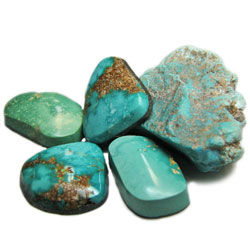

Like amber and jade, turquoise is a semi-precious stone that has been used in jewelry for millennia. In many cultures of both the Old and New Worlds this gemstone has been considered a holy stone and bringer of good fortune. Found in only a few places around the world, places that are dry and where acidic, copper-rich groundwater seeps downward and reacts with minerals that contain phosphorus and aluminum, Turquoise is increasingly harder to find as many of the historical sites have been mined out. Fortunately, however, turquoise is still often discovered as a byproduct of large-scale copper mining operations in the United States.
| Chemical Formula | CuAl6(PO4)4 (OH)8 • 4H2O | Mineral Class | Turquoise |
|---|---|---|---|
| Color | Blue to green | ||
| Crystal System | Triclinic | Hardness | 5-6 |
| Transparency | Opaque | Luster | Waxy |
| Refractory Index | 1.610 - 1.650 | Double Refraction | Not detectable |
Turquoise has long been considered a stone that guarantees health, good fortune, and protection from evil.
The Apaches believed that turquoise attached to a bow or firearm increased a hunter’s or warrior’s accuracy.
The goddess Hathor was associated with turquoise, as she was the patroness of Serabit el-Khadim, where it was mined. Her titles included "Lady of Turquoise", "Mistress of Turquoise", and "Lady of Turquoise Country".
Turquoise is credited with the property of securing friendly regard, verifying the traditional saying that “He, or she, who owns a turquoise will never want for a friend".
In the Orient, a turquoise ring was worn as a protector against all things evil.
Native Americans saw turquoise as a sign of divinity and power because it stole its color from the sky and sea.
The Hopi worship a god of turquoise and embed the stone into beams and posts of their places of worship.
Early Persians thought it cured epilepsy and insanity.
Medieval Europeans used pulverized turquoise to cure eye ailments, ulcers, and heartburn.
As late as the seventeenth century turquoise was cosidered effective only if received as a gift.
Tibetans cosider turquoise a stone of good fortune, health, and protection against contagion and the "evil eye".
The Pueblo Indians of the American Southwest, also following centuries old traditions, venerate turquoise, use it in jewelry, and put it under the floor of new houses or ceremonial structures for good luck and protection.